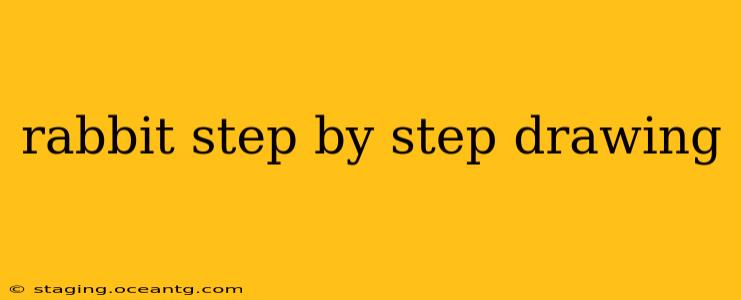Learning to draw a rabbit can be a fun and rewarding experience, regardless of your skill level. This step-by-step guide will walk you through the process, from simple shapes to adding intricate details, allowing you to create a realistic or stylized bunny depending on your preference. We'll cover various approaches and address common questions, ensuring you achieve a satisfying result.
Step 1: Basic Shapes – The Foundation of Your Rabbit
Begin by sketching lightly with a pencil. Don't press too hard; you'll want to easily erase any mistakes. Start with the basic shapes that make up a rabbit's body:
- Head: A large, slightly rounded oval.
- Body: A smaller, slightly elongated oval, connected to the head. Think of it as a slightly flattened circle.
- Ears: Two long, upright ovals, connected to the top of the head. One ear might be slightly angled, giving a more natural look.
- Tail: A small, fluffy circle at the bottom of the body.
These basic shapes are your blueprint. Don't worry about perfection at this stage; it's about establishing the overall proportions and posture of your rabbit.
Step 2: Refining the Shapes – Adding Structure
Now, let's refine those initial shapes to better resemble a rabbit.
- Head: Slightly curve the top of the head oval, adding a gentle slope towards the muzzle.
- Body: Smooth out the connection between the head and body ovals. Slightly curve the bottom of the body to indicate a rounded belly.
- Ears: Make the tops of the ears slightly pointed. Add a subtle curve to the insides of the ears.
- Legs: Add four small, slightly curved rectangles for the legs – two front and two back.
At this stage, your rabbit should be starting to look more defined. Still, keep your lines light and ready to adjust.
Step 3: Adding Details – Eyes, Nose, and Mouth
Now it's time to bring your rabbit to life with the facial features.
- Eyes: Add two small circles or ovals for the eyes, placed relatively close together on the head. Consider adding small dots inside for pupils.
- Nose: Draw a small triangle or a teardrop shape for the nose.
- Mouth: Add a small curved line for the mouth, suggesting a gentle smile or a slightly open expression.
Remember to keep the proportions in mind; the eyes, nose, and mouth should be appropriately sized relative to the head.
Step 4: Fur and Texture – Bringing Your Rabbit to Life
To make your rabbit drawing truly captivating, consider adding fur texture. You can do this by adding short, light strokes around the edges of the body and head, suggesting the fluffiness of rabbit fur. Adding subtle shading will also help enhance the three-dimensionality of your drawing.
How to Draw a Realistic Rabbit?
Achieving realism involves careful observation and attention to detail. Study reference images of rabbits to understand their anatomy, particularly the musculature and proportions. Pay close attention to the shape of the head, the placement of the ears, and the overall body posture. Accurate proportions are key to realistic representation. Use shading and highlighting techniques to mimic the texture of the fur and add depth.
How to Draw a Cartoon Rabbit?
Cartoon rabbits can be very expressive and fun to draw. Begin with simplified shapes, emphasizing roundness and exaggerated features. Large, expressive eyes, a small nose, and a cheerful mouth are typical characteristics. Don't worry about anatomical accuracy; focus on creating a charming and appealing character. Consider adding color to add to the playfulness.
What are the Different Types of Rabbits?
There's a wide variety of rabbit breeds, each with its own unique characteristics. From the floppy-eared lop to the energetic Dutch rabbit, their physical features can vary considerably. Researching different breeds will help you draw more specific and accurate representations.
What are the Best Materials for Drawing a Rabbit?
While you can use any drawing materials you prefer, a good quality pencil (such as an HB or 2B) is ideal for sketching. You may also want an eraser for correcting mistakes, and possibly a fine-liner pen for inking your final drawing if you choose. Consider adding colored pencils or watercolors to add further depth and realism.
This guide provides a framework. Experiment, have fun, and remember that practice is key to improving your drawing skills. Don't be afraid to try different styles and techniques to find what works best for you.
